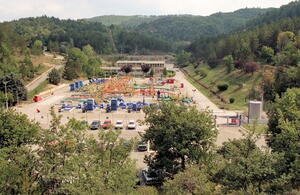Mammoth-scale oil tank
This is the national equivalent of a domestic oil tank: France's largest and most secure strategic oil reserve is housed deep in the salt substratum of the Luberon mountains, some 10 kilometres north of Manosque, with 26 underground cavities, each of them as high as the Eiffel Tower and as wide as the Jefferson Monument.
Created forty years ago, this underground installation known as "Geosel" stores more than six million cubic metres of crude oil, gasoline and fuel. In the case of a crisis, this reserve would cover the needs of the French population for three weeks.
Geosel is connected to the petroleum installations on the Etang de Berre by way of a pipeline network. Should a major shortage occur, oil could be pumped out of the caves into the refineries, and gasoline and diesel directly into the storage tanks at Shell or Total. No such shortage has occurred since Geosel was created in 1969, however, and the facility has been used mainly to accommodate the industry's storage needs.
Work on the Geosel installations started in 1965 and was completed four years later. How does one create such a mammoth underground facility? "Salt is easily dissolved by water," explains Alain Herfray, Geosel installation chief. "Using oil industry techniques, a well was drilled for each of the 26 projected cavities. Drilling went through the roof of the salt dome and kept going until it reached a depth of 500 to 1,000 metres. Pressurized water was then injected, which caused the salt to slowly dissolve. Two to three years into this process, and bottle-shaped, water-tight cavities were born and available to store from 100,000 to 500,000 cubic metres of fuel..."
Since the cavities have to remain filled to the rim at all times, there is a constant flux of oil and brine in and out of the Geosel. Close to the installation two artificial ponds, each with a capacity of 100,000 cubic metres, act as buffers to retain the brine, which is then flushed into two lakes in the vicinity of Istres, close to the Fos-sur-Mer harbour.
Geosel is as monumental as it is inconspicuous: an ordinary administrative building, an array of pipes and choke manifolds are the only telling signs of this strange and amazing subterranean realm.


